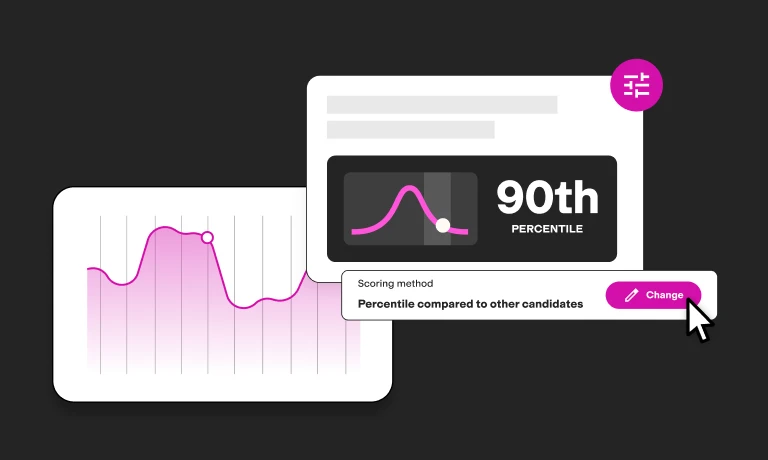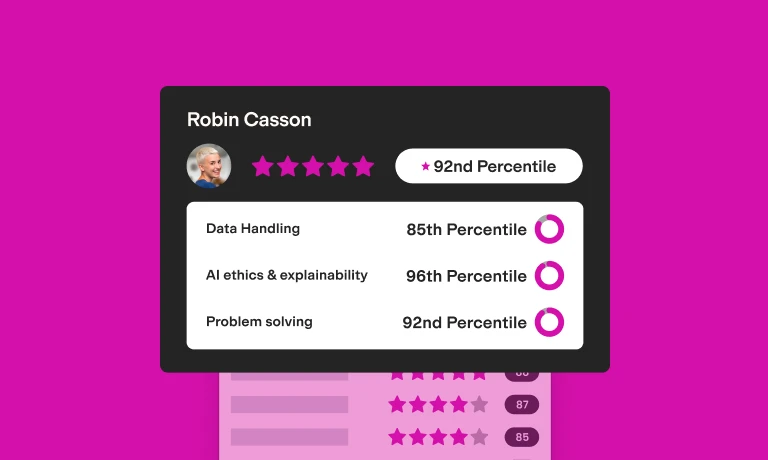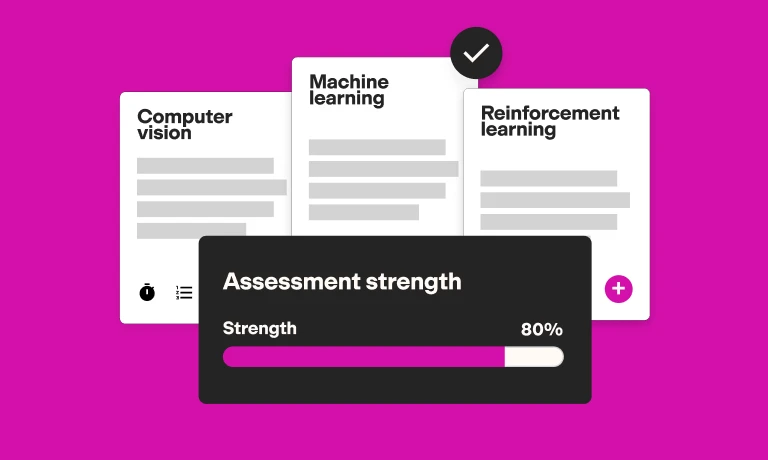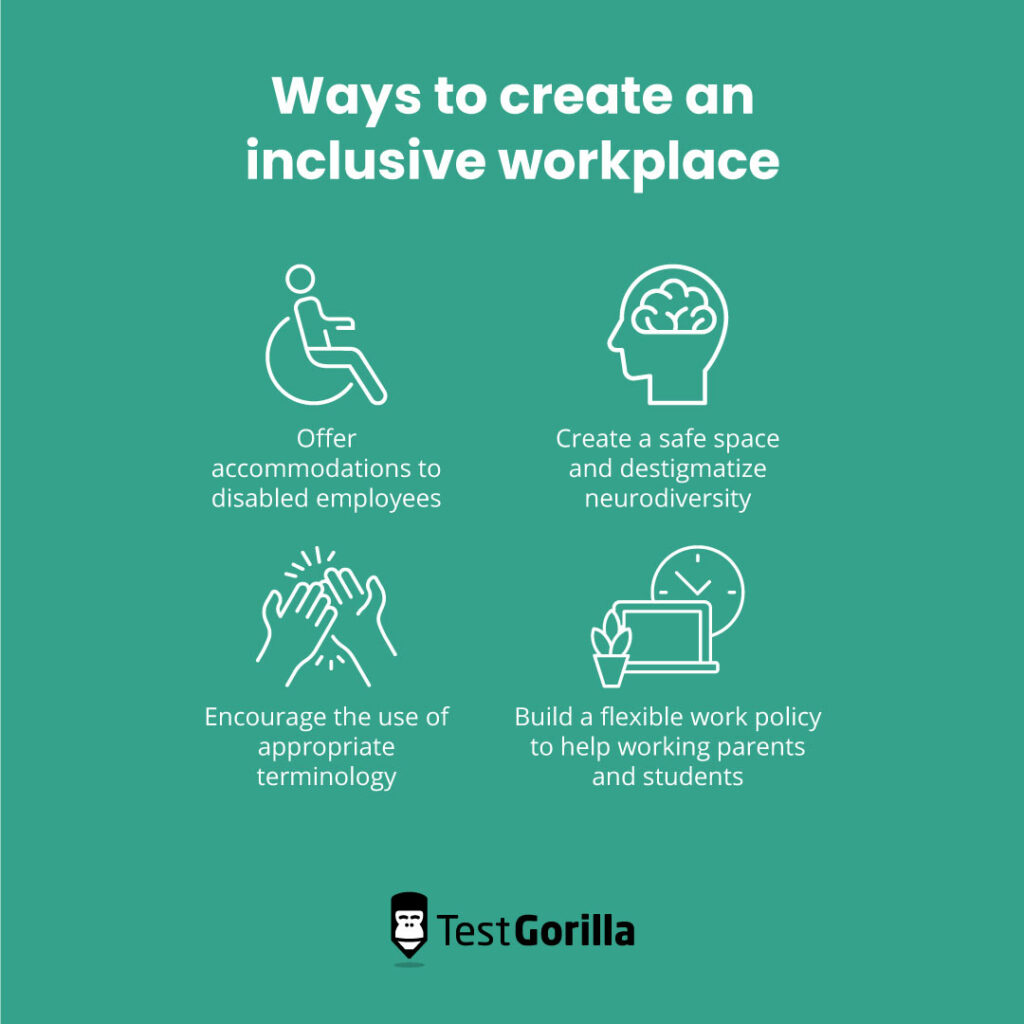The problem with DE&I targets: Are they the best way to promote inclusion?
Diversity isn’t just good for business – it’s necessary.
Hiring a diverse workforce promotes innovation, productivity, and better financial performance. Besides business benefits, it’s the right thing to do.
Many companies plan on achieving this goal by establishing diversity and inclusion targets, but are they the most effective way to increase diversity in your organization?
These goals are well-intentioned but problematic. To properly reap the benefits of diversity, it has to be natural.
You can’t establish a number for diversity and just strive to attain it.
Let’s take a look at DE&I targets. Do they promote diversity and achieve their intended goals? Or are they treated as a checkbox goal?
We also discuss two surefire ways to improve diversity in your organization: skills-based hiring and an inclusive company culture.
Why did DE&I targets come about?
First and foremost, diversity, equity, and inclusion (DE&I) targets came about because of a demand for equality. Employees, stakeholders, and customers wanted more gender and racial diversity in the workplace, and companies had to react.
This demand also meant that public sentiment is more favorable towards organizations that seem more inclusive, and top-tier talent wants to work at inclusive, diverse companies.
One of the first DE&I hiring initiatives was the Civil Rights Act of 1964, which forbade discrimination based on sex and race in hiring, promoting, or firing.
Another major event in the history of DE&I targets is the Workforce 2000 study from 1987, a study by the Hudson Institute showing that the United States would have to diversify to stay competitive with other regions.
Because of this, many studies took place to prove the efficacy of diversity and make a “business case.” Organizations then created targets to reach these goals and reap these benefits.
According to TestGorilla’s State of Skills-Based Hiring 2022 report, 76.8% of companies have DE&I as a current objective and 91% of skills-based organizations saw an increase in diversity.
Diversity alone can’t boost a business. To truly harness the benefits of a diverse team, an organization has to focus on how it handles diversity.
In addition, it should promote a culture of inclusivity, and hire its talent in line with these goals (more on that later).
Let’s clear something up right away: DE&I targets are well-intentioned.
Here are a few examples of companies establishing well-intentioned targets:
Google established leadership diversity targets and achieved 30% of underrepresented minorities in leadership positions three years before its original target date of 2025
Slaughter and May introduced its first diversity goals by aiming to have 40% female partner promotions by 2027
Some companies could be establishing targets to become part of a trend – but many companies using these targets are doing so because they want to achieve a better, fairer workplace, unaware of the many hidden drawbacks of this method.
The answer to achieving true, fair diversity is nurturing inclusivity and hiring for skills rather than pre-established targets.
Organizations that use DE&I targets are on the right side of history, but it’s time to examine the efficacy of these targets.
Do diversity and inclusion targets work?
They can work, but the answer is a little more nuanced than that.
Generally, the issue with DE&I targets is how you establish them.
Often, management is well-intentioned and wants to increase diversity, but it doesn’t know how to properly use targets.
It can choose targets that aren’t viable and end up failing.
According to our report, more than 30% of companies that don’t use skills-based hiring have no documented processes to reduce unconscious bias during hiring.
Without eliminating or at least mitigating unconscious bias, even if you establish a target, there’s not a lot of visibility or understanding of how you are meeting it.
Companies don’t always consider the demographic makeup of their location or industry.
For example, establishing a target of 30% more ethnic minority trainees by the end of the year isn’t viable in an area with an overwhelmingly White population.
Bristol Myers recently announced its successful and failed diversity goals, meeting its goals for 6% representation of Black people in executive roles but falling short on its targets for 7.4% representation of Hispanic people and 50% female representation in executive roles.
To combat this, it aimed higher and now has a goal of 11% representation of Hispanic executives.
A target like this is a positive goal to have, but it can be unrealistic. If you didn’t hit your first goal, aiming higher without a change in the process probably won’t change the outcome.
Organizations also need to examine their current workforce for targets to be effective – it helps them understand where they’re starting from.
Understanding current needs is crucial because many companies fail when they don’t understand who is needed, when, and where.
You need to assess your company’s workforce and culture before deciding on goals. Otherwise, initiatives may not address real needs or the right issues.
For example, a company creates a DE&I target to hire 20% more women into middle management roles. Had it assessed these roles, it would have found it already has 45% representation for women in middle management, but it’s lacking in senior management roles.
Failing to address real needs leads to DE&I targets that are more of a “trend” or a “checkbox exercise.”
This issue also presents itself when targets are established intentionally low. Is it a win for diversity to hit them, or is it another business tickbox?
Do they result in true diversity and inclusion?
Unfortunately, DE&I targets don’t always result in more diversity.
Even after decades of establishing DE&I targets, we continue to see diversity crawl upward at a disappointing rate:
From 2009 to 2018, the percentage of Black law partners went from 1.7% to 1.8%
From 2010 to 2019, the percentage of women in management increased by 2%
, yet the pay gap remained the same
From 1985 to 2016, the proportion of Black men in management at U.S. companies with 100 or more employees went from 3% to 3.2%
That last point is particularly shocking – only a 0.2% percent increase after 31 years of progress.
A separate study examined DE&I targets for twenty-three law firms. The results show that 10 firms hit their targets, but 13 missed them.
This situation isn’t uncommon. The fourth annual review by the Women in Finance Charter found that 30% of law firms failed to reach their gender diversity goals.
These studies show that diversity targets don’t always work, but it’s more than that – they also don’t target all forms of diversity.
Do most DE&I targets consider all aspects of diversity, or are they limited to one definition?
Most DE&I targets focus on gender and race, and while these demographics are essential to a healthy, diverse culture, these targets ignore other avenues of diversity.
Here are a few underrepresented channels of diversity:
Disability
Neurodiversity
Thought and beliefs
Sexual orientation
Religious affiliation
Age
Nationality
Neglecting to consider channels like age, disability, and neurodiversity is leading to an unfortunate amount of age discrimination and contributing to the wide ASD employment gap.
When DE&I targets ignore these avenues, companies leave these diverse people out of diversity hiring initiatives, making employment gaps increasingly worse.
Considering all avenues of diversity is one of our top tips in our article on diversity recruiting 10 dos and don’ts.
DE&I targets also focus on the hiring process alone – not everything that happens after the candidate accepts the offer.
True diversity is about creating a safe, inclusive space for all types of employees and nurturing a healthy organizational culture (we’ll speak about this in-depth later on).
The bottom line is that diversity isn’t just about increasing a specific demographic. It’s about getting solid, diverse talent from multiple avenues and building a positive culture where they can thrive.
Do they help businesses achieve their financial goals?
Many instances have shown that diversity helps business goals, such as improved productivity, innovation, and financial performance.
But these benefits come from true diversity – not establishing targets and numbers through any means.
Often, DE&I targets don’t help businesses achieve higher innovation and performance because:
They aren’t reaching all channels of diversity
They aren’t building a safe, inclusive workplace
They aren’t embodying diversity as a whole as a base principle
And what’s worse, when these targets fail to achieve the desired goals, the company loses motivation for the project and cuts funding.
When a highly touted initiative fails to deliver on big promises, stakeholders aren’t likely to put more money into it.
So, are DE&I targets an idea we should stick with? Or were they simply a necessary step towards real diversity, and we’re now ready to move on to better options?
We don’t believe that organizations have to toss these targets out completely. However, your highest priority should be hiring the best candidate for the role by assessing skills and capabilities.
If your company believes targets are a valuable part of your strategy, you can try establishing skills-based targets such as “hire X% STARs candidates” or “upskill X% of employees.”
For more insights on this topic, check out our blog on the best practices to make your company more diverse and inclusive.
The best insights on HR and recruitment, delivered to your inbox.
Biweekly updates. No spam. Unsubscribe any time.
The ideal way to promote diversity: Skills-based hiring practices
If you want to increase your diversity and promote a company culture where employees thrive, the answer is adopting skills-based practices.
You can achieve real diversity through fair hiring, a strong company culture, and inclusivity, rather than a target based on a misunderstood notion of diversity.
Skills-based hiring has proven its effectiveness.
DE&I targets don’t have a great track record, but according to TestGorilla’s State of Skills-Based Hiring report, 91% of employers saw an increase in diversity using skills-based hiring practices.
Skills-based practices also help organizations hit other crucial business goals. Among organizations that adopted skills-based hiring practices:
89.8% saw an increase in retention
92.5% saw a reduction in mis-hires
72.1% of the employees hired via skills-based hiring are happy in their roles
Skills-based hiring naturally increases your company’s diversity and brings in the best talent from all over the world by reducing unconscious biases and promoting a fairer, more inclusive recruitment process.
One of the key elements of skills-based recruiting practices is skills tests. Pre-employment skills testing helps hiring managers assess skill and capability objectively, leading to stronger hires and a fair process that finds the best candidate.
Here’s an example skills assessment for a growth marketer:
Growth Marketing test
Branding Strategy test
Verbal Reasoning test
Communication test
Culture Add test
You can find all of these tests and many more in our test library.
This assessment enables HR professionals to test candidates, review the results, and hire the person who scores the highest – regardless of their background, gender, race, or age.
Steelcase, an office furniture company, adopted skills-based hiring as a part of its DE&I strategy.
Its hiring process now prioritizes skills more than resumes, removes experience requirements wherever possible, and promotes continuous improvement more than perfection.
Since the start of this process, Steelcase’s new hires have been 54.5% women, and 76% of its interns are either minorities or women in STEM.
Skill assessments also reassure candidates that you know they can do the job and don’t need “help.”
Christian Watson, a philosophy student and political writer, says that this is why DE&I targets can be damaging to many groups of candidates.
He adds that giving marginalized communities assistance to get hired implies that a particular demographic is an obvious choice and more talented by default.
Combining skills tests with other skills-based recruitment methods improves diversity further. Examples include using anonymous applications, tossing away the resume, and using structured interviews instead of unstructured interviews.
Unstructured interviews leave room for unconscious bias that can reduce diversity. These interviews heavily rely on confidence and charisma, filtering out excellent candidates who don’t have the “right charm” or don’t interview well.
To read about this in-depth, read our article on unconscious bias at the interview table.
Skills-based hiring practices nurture an organic approach to building diverse teams, one that candidates and companies can agree is fair and not divisive.
DE&I targets and quotas are problematic because they can cause resentment across all groups. They can cause statements like:
“You only hired me because I’m XYZ.”
“I didn’t get the job because I’m not XYZ.”
Both sides of this can fall under the category of unfair hiring. Skills-based hiring leaves the decision up to skills – making it objective.
Focusing on targets also forces a team to focus on what divides us, rather than what unites us. This sort of atmosphere is damaging to team mindsets, morale, and company culture.
On the other hand, hiring for culture with our Culture Add test brings teams together, gradually nurturing a healthy, inclusive culture built on diverse people and the factors that unite them.
Build an inclusive workplace to achieve a diverse workplace
An inclusive, diverse workplace doesn’t stop at the recruitment stage. Post-hiring policies and healthy work cultures are imperative for a truly inclusive work environment.
Companies need to be accommodating, welcoming, and respectful of the diversity they recruit or it won’t work out.
Many DE&I initiatives go wrong because they focus on targets and overlook their culture. If an organization treats diversity like a checkbox, it can lead it to think it’s achieved diversity and inclusion right after hiring.
Companies could target certain demographics, hire them, then neglect to create an environment that helps them develop and thrive.
Diversity without inclusivity and fairness doesn’t resolve anything.
Hiring a working mother is a step in the right direction, but unless you provide her with a flexible schedule so she can work around her child’s needs, you aren’t being truly inclusive.
A study conducted by Daan van Knippenberg and Michaéla C. Schippers found that the benefits associated with diversity, such as innovation, can’t happen unless a workplace also provides psychological safety.[1]
Forbes describes a psychologically safe workplace as the evolution of inclusion – the next step to a truly harmonious company culture.
Organizations must provide employees with a safe space to be themselves, ask questions, and take risks. To learn about this in-depth, read our blog post on psychological safety.
Inclusivity means treating all employees equally, enabling them to feel comfortable, and ensuring they have the means to accomplish their work effectively.
Here are a few ways to create an inclusive workplace:
Offer accommodations to disabled employees
Create a safe space and destigmatize neurodiversity
Encourage the use of appropriate terminology
Build a flexible work policy to help working parents and students
These actions not only help the employees they directly affect. The more you spread inclusivity, the more the rest of your workforce respects the company.
People care about a company’s values, and employees notice positive, inclusive actions.
Promote true diversity through skills-based hiring
DE&I targets come from the right place in history, but perhaps that’s what they are: history.
These targets don’t work as intended, and now we have methods of achieving the diversity our organizations need, and our people demand.
The modern age provides us with easy access to skills-based hiring practices, such as skills tests, so we can objectively assess every candidate’s skills.
To see diversity flourish, we must focus on real capabilities and hire whoever is best for the role.
To continue learning about the benefits of diversity, read our article on how a diverse workforce can transform your business.
Or, if you’d like to learn a little more about skill assessments, check out our test library of more than 300+ tests.
Source
van Knippenberg D, Schippers MC. (2007). “Work group diversity”. Annu Rev Psychol. Retrieved March 9, 2023. https://pubmed.ncbi.nlm.nih.gov/16903805/
You've scrolled this far
Why not try TestGorilla for free, and see what happens when you put skills first.

















